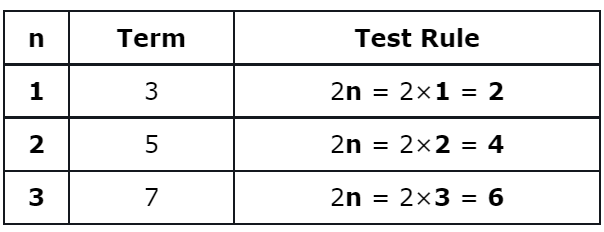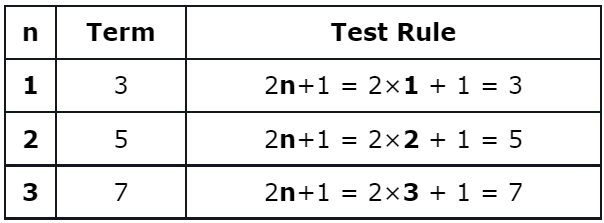Sequence | Mathematics for ACT PDF Download
What is a Sequence?
A Sequence is a list of things (usually numbers) that are in order.
Infinite or Finite
When the sequence goes on forever it is called an infinite sequence, otherwise it is a finite sequence
Examples:
{1, 2, 3, 4, ...} is a very simple sequence (and it is an infinite sequence)
{20, 25, 30, 35, ...} is also an infinite sequence
{1, 3, 5, 7} is the sequence of the first 4 odd numbers (and is a finite sequence)
{4, 3, 2, 1} is 4 to 1 backwards
{1, 2, 4, 8, 16, 32, ...} is an infinite sequence where every term doubles
{a, b, c, d, e} is the sequence of the first 5 letters alphabetically
{f, r, e, d} is the sequence of letters in the name "fred"
{0, 1, 0, 1, 0, 1, ...} is the sequence of alternating 0s and 1s (yes they are in order, it is an alternating order in this case)
In Order
When we say the terms are "in order", we are free to define what order that is! They could go forwards, backwards ... or they could alternate ... or any type of order we want!
Like a Set
A Sequence is like a Set, except:
- the terms are in order (with Sets the order does not matter)
- the same value can appear many times (only once in Sets)
Example: {0, 1, 0, 1, 0, 1, ...} is the sequence of alternating 0s and 1s.
The set is just {0,1}
Notation
Sequences also use the same notation as sets: list each element, separated by a comma,
and then put curly brackets around the whole thing. {3, 5, 7, ...}
The curly brackets { } are sometimes called "set brackets" or "braces".
A Rule
A Sequence usually has a Rule, which is a way to find the value of each term.
Example: the sequence {3, 5, 7, 9, ...} starts at 3 and jumps 2 every time: 
As a Formula
Saying "starts at 3 and jumps 2 every time" is fine, but it doesn't help us calculate the:
- 10th term,
- 100th term, or
- nth term, where n could be any term number we want.
So, we want a formula with "n" in it (where n is any term number).
So, What Can A Rule For {3, 5, 7, 9, ...} Be?
Firstly, we can see the sequence goes up 2 every time, so we can guess that a Rule is something like "2 times n" (where "n" is the term number). Let's test it out:
Test Rule: 2n 
That nearly worked ... but it is too low by 1 every time, so let us try changing it to:
Test Rule: 2n+1 That Works!
That Works!
So instead of saying "starts at 3 and jumps 2 every time" we write this:
2n+1
Now we can calculate, for example, the 100th term: 2 × 100 + 1 = 201
Many Rules
But mathematics is so powerful we can find more than one Rule that works for any sequence.
Example: the sequence {3, 5, 7, 9, ...}
We have just shown a Rule for {3, 5, 7, 9, ...} is: 2n+1
And so we get: {3, 5, 7, 9, 11, 13, ...}
But can we find another rule?
How about "odd numbers without a 1 in them":
And we get: {3, 5, 7, 9, 23, 25, ...}
A completely different sequence!
And we could find more rules that match {3, 5, 7, 9, ...}. Really we could.
So it is best to say "A Rule" rather than "The Rule" (unless we know it is the right Rule).
Notation
To make it easier to use rules, we often use this special style:
Example: to mention the "5th term" we write: x5
So a rule for {3, 5, 7, 9, ...} can be written as an equation like this:
xn = 2n+1
And to calculate the 10th term we can write:
x10 = 2n+1 = 2×10+1 = 21
Can you calculate x50 (the 50th term) doing this?
Here is another example:
Example: Calculate the first 4 terms of this sequence:
{an} = { (-1/n)n }
Calculations:
- a1 = (-1/1)1 = -1
- a2 = (-1/2)2 = 1/4
- a3 = (-1/3)3 = -1/27
- a4 = (-1/4)4 = 1/256
Answer: {an} = { -1, 1/4, -1/27, 1/256, ... }
Special Sequences
Now let's look at some special sequences, and their rules.
Arithmetic Sequences
In an Arithmetic Sequence the difference between one term and the next is a constant.
In other words, we just add some value each time ... on to infinity.
Example: 1, 4, 7, 10, 13, 16, 19, 22, 25, ...
This sequence has a difference of 3 between each number.
Its Rule is xn = 3n-2
In General we can write an arithmetic sequence like this:
{a, a+d, a+2d, a+3d, ... }
where:
- a is the first term, and
- d is the difference between the terms (called the "common difference")
And we can make the rule:
xn = a + d(n-1)
(We use "n-1" because d is not used in the 1st term).
Geometric Sequences
In a Geometric Sequence each term is found by multiplying the previous term by a constant.
Example: 2, 4, 8, 16, 32, 64, 128, 256, ...
This sequence has a factor of 2 between each number.
Its Rule is xn = 2n
In General we can write a geometric sequence like this: {a, ar, ar2, ar3, ... }
where:
- a is the first term, and
- r is the factor between the terms (called the "common ratio")
Note: r should not be 0.
- When r=0, we get the sequence {a,0,0,...} which is not geometric
And the rule is:
xn = ar(n-1)
(We use "n-1" because ar0 is the 1st term)
Triangular Numbers
1, 3, 6, 10, 15, 21, 28, 36, 45, ...
The Triangular Number Sequence is generated from a pattern of dots which form a triangle:
By adding another row of dots and counting all the dots we can find the next number of the sequence.
But it is easier to use this Rule: xn = n(n+1)/2
Example:
- the 5th Triangular Number is x5 = 5(5+1)/2 = 15,
- and the sixth is x6 = 6(6+1)/2 = 21
Square Numbers
1, 4, 9, 16, 25, 36, 49, 64, 81, ...
The next number is made by squaring where it is in the pattern.
Rule is xn = n2
Cube Numbers
1, 8, 27, 64, 125, 216, 343, 512, 729, ...
The next number is made by cubing where it is in the pattern.
Rule is xn = n3
Fibonacci Sequence
0, 1, 1, 2, 3, 5, 8, 13, 21, 34, ...
The next number is found by adding the two numbers before it together:
- The 2 is found by adding the two numbers before it (1+1)
- The 21 is found by adding the two numbers before it (8+13) etc...
Rule is xn = xn-1 + xn-2
That rule is interesting because it depends on the values of the previous two terms.
Rules like that are called recursive formulas.
The Fibonacci Sequence is numbered from 0 onwards like this: 
Example: term "6" is calculated like this:
x6 = x6-1 + x6-2 = x5 + x4 = 5 + 3 = 8
Series and Partial Sums
Now you know about sequences, the next thing to learn about is how to sum them up.
When we sum up just part of a sequence it is called a Partial Sum.
But a sum of an infinite sequence it is called a "Series" (it sounds like another name for sequence, but it is actually a sum). See Infinite Series.
Example: Odd numbers
Sequence: {1, 3, 5, 7, ...}
Series: 1 + 3 + 5 + 7 + ...
Partial Sum of first 3 terms: 1 + 3 + 5
|
144 videos|104 docs|61 tests
|





















